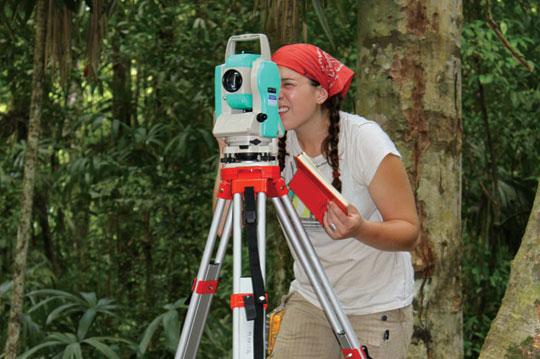Exploring Ancient Maya Sites in Belize
In the jungles of Belize, one kilometer from the ancient Maya center at Dos Hombres, Cal Poly Humboldt students and professor of anthropology, Marisol Cortes-Rincon, discovered the location of a Maya temple dating to somewhere between 250 and 900 A.D.
“From the top of a knoll, we saw large architecture,” Cortes-Rincon says. “When we realized what we found, we were like little kids. All the students, including myself, were dancing around.”
Humboldt undergrads tracked down the temple’s limestone remains. They also found indications of a system of caves beneath the structure and water management features. The Maya believed caves and water were means to connect to the underworld.
The temple was discovered in summer 2010 as part of the Humboldt Belize Archaeology Field Program. The temple’s site is located on 250,000 acres of land managed by the University of Texas at Austin. Humboldt’s specific project is to create a detailed survey of the ancient Maya centers at Dos Hombres and Gran Cacao. The area is 12 kilometers long and between 150 and 300 meters wide through dense jungle.
“People have been talking about this project since I was a volunteer in ’96 or ’97. But no one has actually done it,” Cortes-Rincon says. “I was curious about this area because nobody else has looked at it.”
The Belize Archaeology Field Program began in the summer of 2010 after Cortes-Rincon joined the Anthropology faculty at Humboldt. The program brings as many as 20 students to the site every year.
“It’s a big deal for undergraduates to get this kind of hands-on fieldwork experience,” Cortes-Rincon says. “And it’s a great experience for people who haven’t traveled.”
Students from any discipline are encouraged to apply to the program. The variety of tasks and opportunities for hands-on research are broad and open to any student who doesn’t mind getting his or her hands dirty.
“We’re mapping, excavating, and looking at ecology. We’re going to start doing soil samples. We can use people with artistic skills to help document the site and artifacts, too,” Cortes-Rincon says. “It doesn’t matter if you’re in Forestry, Architecture, Photography or Geology. We can help students find a project they care about and want to take ownership of. We also rotate duties to make sure people get to experience different kinds of activities.”
Students who enroll in the program share camp with up to 120 students from a number of universities who share access to the 250,000-acre site. “Dinnertime conversations are really interesting,” Cortes-Rincon says. “You get to hear what other people are doing and finding, compare notes and share interests. It’s a great way to find interesting graduate projects.”
On weekend outings, Humboldt students are also introduced to the local culture. “We visit places like (ancient Maya sites) Lamanai and La Milpa, and students can earn three units of cultural anthropology studying the culture of Belize,” Cortes-Rincon says. “It’s a diverse community and you hear a lot of different languages.”
Taken from: Humboldt NOW

